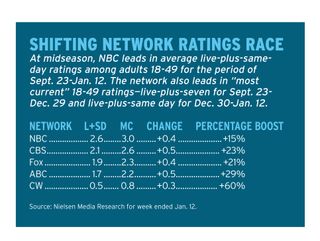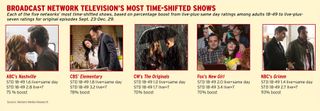Let’s Do the Time Shift Again

CBS Entertainment president Nina Tassler opened her executive session last week at the TCA winter press tour by addressing the quickening pace at which the industry is evolving, and one of the major contributing factors for that speed. “Time-shifted viewing continues to soar,” she said. “DVR, VOD and streaming numbers are all up. VOD has seen a sizable jump this year, and three-day DVR playback lifts now look a lot like sevenday lifts from about a year ago.” It was a billboard statement underscoring that time-shifted viewing is more of a factor for programmers than ever.
For the season so far in adults 18-49 live-plus-sameday (L+SD) rating, NBC leads the Big Four with an average 2.6, followed by CBS (2.1), Fox (1.9) and ABC (1.7), according to Nielsen data for Sept. 23-Jan. 12.
While the rankings don’t change when delayed viewership is factored in—CBS and ABC each gain half a point; NBC and Fox lift four tenths—the percentage gains are quite different.
Of course, whenever a smaller number increases, the percentage change is bound to be bigger. But it’s worth noting that when ranking season-to-date ratings by percentage gained by delayed viewing, the order is a nearreversal of the L+SD rankings: ABC, up 29%, leads, followed by CBS (23%), Fox (21%) and NBC (15%).
The CW, not surprisingly given its lower average rating and platform savvy younger target audience, gets the highest percentage pop at 60%. NBC’s lead at midseason, while having a lower average dollop added from time shifted viewing, can be explained at least in part by its fall performance being driven by Sunday Night Football. Sports, of course, are so valuable because viewers love watching games live.
Shifted viewing data can certainly signal how a show is connecting with viewers. Lots of delayed viewing obviously bodes well for a show, but some execs say it’s more of a knock on an ongoing scripted series if it doesn’t show significant playback than a big bump helps a show.
Whether or not TV’s most recent TV season demo champ, CBS, grabs that title again, it is well positioned to grab a new bragging right: the most-played back crown. It has 10 of the top 20 non-football series from Sept. 23 through Dec. 29 in L+SD and more top 20 shows in L+7 than any other network, with seven.
Broadcasting & Cable Newsletter
The smarter way to stay on top of broadcasting and cable industry. Sign up below
And according to Brad Adgate, senior VP and director of research at Horizon Media, “Shows that are popular live are also popular on demand.”
Finding the Right Data Point
But that doesn’t mean that networks are programming to DVRs. At least not yet. When tracking average performance network-wide, the Big Four broadcasters focus on live-plus-same-day and live-plus-seven-days. But when looking at individual shows, live-plus-three— the number closest to the C3 rating that networks sell to advertisers—emerges as a third major data point.
According to Kelly Kahl, senior executive VP, CBS primetime, no one number is more important than the others when it comes to programming decisions. What matters are trends. Big gains in L+3 and L+7 can reveal audience interest not indicated in the live-plus-sameday numbers. Kahl points to heavy time-shifted viewing of Elementary and Person of Interest, CBS’ most time-shifted dramas. While neither is considered lowrated, the actual audience and appeal for the shows proves considerably greater than the live numbers.
Still, as long as the ad currency remains C3 (a point CBS topper Leslie Moonves often and clearly challenges), and “even though people do have the ability to watch a few days later,” Kahl says, “the onus is still on us to infuse the shows with excitement and try to get people there when they air.”
The CW, with its 18-34 target, has for years been developing ways to get paid on their non-traditional viewership. And network president Mark Pedowitz knows his audience. The CW develops their shows with the viewers’ habits in mind. “We hope that they watch it whenever they’re going to come,” he says.
As delayed viewership continues to grow overall in the TV landscape, expect programmers to start tweaking their strategies accordingly. As Pedowitz put it, “We’re all going to have to find ways to get more money for days four through 28.”

